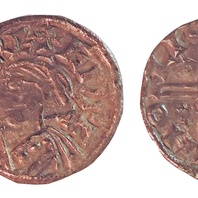
Viking Objects
Northumbrian Penny (NLM-0D491E)
This silver penny was minted in the name of King Eanred of Northumbria. The obverse shows a possibly helmeted and cuirassed individual and reads +EANRE AD RE; the initial cross doubles as X. The reverse reads +CO/ER/[?I]/HO/LI. This particular example was likely brought to Nottinghamshire from Northumbria by means of the Great Army’s overwintering activities in and around Nottingham.
Read More
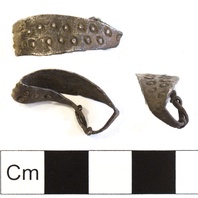
Viking Objects
Stamped Finger Ring (NCL-90DD85)
A silver finger ring made from a sheet of silver cut to size featuring circular punched decoration. Rings like this with knotted ends are typically Scandinavian.
Read More
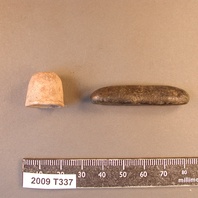
Viking Objects
Breedon Silver Ingot (X.A208.2010.0.0)
A cast silver ingot of typical Viking type. The photograph shows it alongside a lead gaming piece of a type that is increasingly being found within the Danelaw. This ingot could have been used as bullion in payments or trade transactions, as well as a source of metal for jewellery making. This particular ingot has slight irregularities from being made in an open mould and has two testing nicks on one edge. The Vikings arriving in England had a bullion economy where they paid for goods with silver that was weighed to an amount agreed between the buyer and the seller. Hacksilver and silver ingots are the most common evidence for their bullion economy. It took some time for the Scandinavian settlers to adopt a monetary economy like that of the Anglo-Saxons, and both systems were used simultaneously for a while before they fully adopted the new system. They were familiar with monetary economies but they treated coins as just another form of silver before adoption of a monetary economy.
Read More
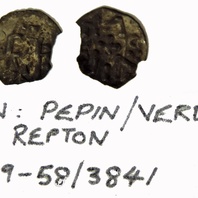
Viking Objects
Coin of Pepin III (1989-58/3841)
This is a silver denier of Pepin III, also known as ‘the Short’ (King of the Franks 751-768), minted at Verdun. The Vikings would have obtained real and imitation Carolingian coins through their raiding and trading activities in the Frankish Empire.
Read More
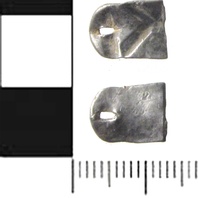
Viking Objects
Mystery Hacksilver
A fragment of silver from an unidentified object. The piece has been pierced at one end but may have come from an armring or other piece of jewellery. As hacksilver, it would have been used to pay for items by weight of silver.
Read More
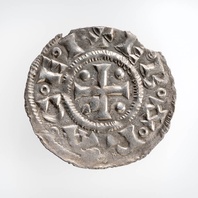
Viking Objects
Northumbrian Viking Penny (CM.952-2000)
This Sword St. Peter type silver penny is not associated with any particular ruler but was minted in the Viking kingdom of Northumbria. The coin features a sword image which is usually considered to represent the sword of St Peter, whose name features on the same side of the coin, and a hammer which is often taken to be Thor’s hammer, thus mixing the iconography of the Christian and Norse religions. It was found as part of the Thurcaston hoard which was probably buried c.923-925 CE, approximately five years after Leicester had been retaken by Mercia (c.918). The coins in the hoard are Anglo-Saxon, Arabic and Danelaw issues, showing the wide-ranging contacts between societies at this time. After the establishment of the Danelaw, some Viking leaders decided to mint their own coins to solidify their legitimacy in the eyes of the local populace. This created a hybrid economy where some members of the Danelaw used bullion and others used coins. The bullion economy resulted in some coins being cut into pieces to pay for items.
Read More
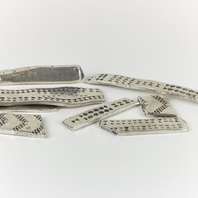
Viking Objects
Reproduction Hacksilver
These white metal reproductions of Viking Age hacksilver are typical of hacksilver finds. The Scandinavians had a bullion economy in the Viking Age and paid for goods by weight of silver rather than by using coins with a set monetary value. Arm rings are one example of wearable wealth that could be cut up to pay for goods when needed.
Read More
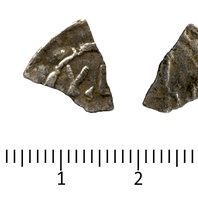
Viking Objects
Arabic Silver Dirham Fragment (SWYOR-1AE8AA)
This silver dirham fragment does not provide enough information to determine the ruler or moneyer but it seems to be from the seventh to ninth century. The dirham was a unit of weight used across North Africa, the Middle East, and Persia, with varying values which also referred to the type of coins used in the Middle East during the Viking Age. These coins were extremely prized possessions not only for their silver value but as a way of displaying one’s wealth and vast trade connections. Millions of Arabic dirhams would have been imported throughout the Viking world and are mostly found in hoards.
Read More
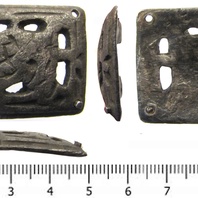
Viking Objects
Anglo-Scandinavian Silver Mount (SWYOR-0201A1)
This silver rectangular mount is decorated with an openwork design consisting of a possible backward-facing animal alongside interlace which may have zoomorphic elements.
Read More
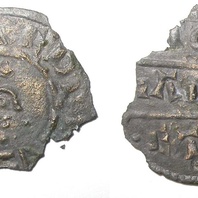
Viking Objects
Coin of Aethelred (1989-58/3395)
A silver penny of Aethelred I of Wessex was found in the mass grave at Repton and minted by a moneyer apparently called Liabinc. The location of minting is unknown. Aethelred I was King of Wessex from 865 until his death in 871. Aethelred’s reign coincided with the arrival of the Viking Great Heathen Army in England and he fought them with little success during their invasion of Wessex which began in 870. After his death, he was succeeded by his youngest brother, Alfred the Great, who carried on the war with the Vikings. Minting coins was a way of controlling the means of exchange within a kingdom and which created a more easily administered standardized system of trade. Moreover, the coins themselves were often used as propaganda, portraying symbols and statements that gave off a desired message. The Vikings later used the minting of coins to legitimize their own rule.
Read More
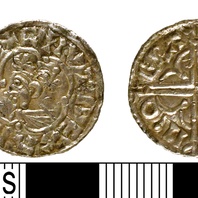
Viking Objects
Coin of Cnut the Great (NARC-5DBF29)
This silver penny was minted in Cambridge for King Cnut the Great, the Danish king who reigned over England from 1016-1035. This particualr coin is is classified as a quatrefoil obverse type. Minting coins was a way of controlling the means of exchange within a kingdom and which created a more easily administered standardized system of trade. Moreover, the coins themselves were often used as propaganda, portaying symbols and statements that gave off a desired message. The Vikings later used the minting of coins to legitimize their own rule.
